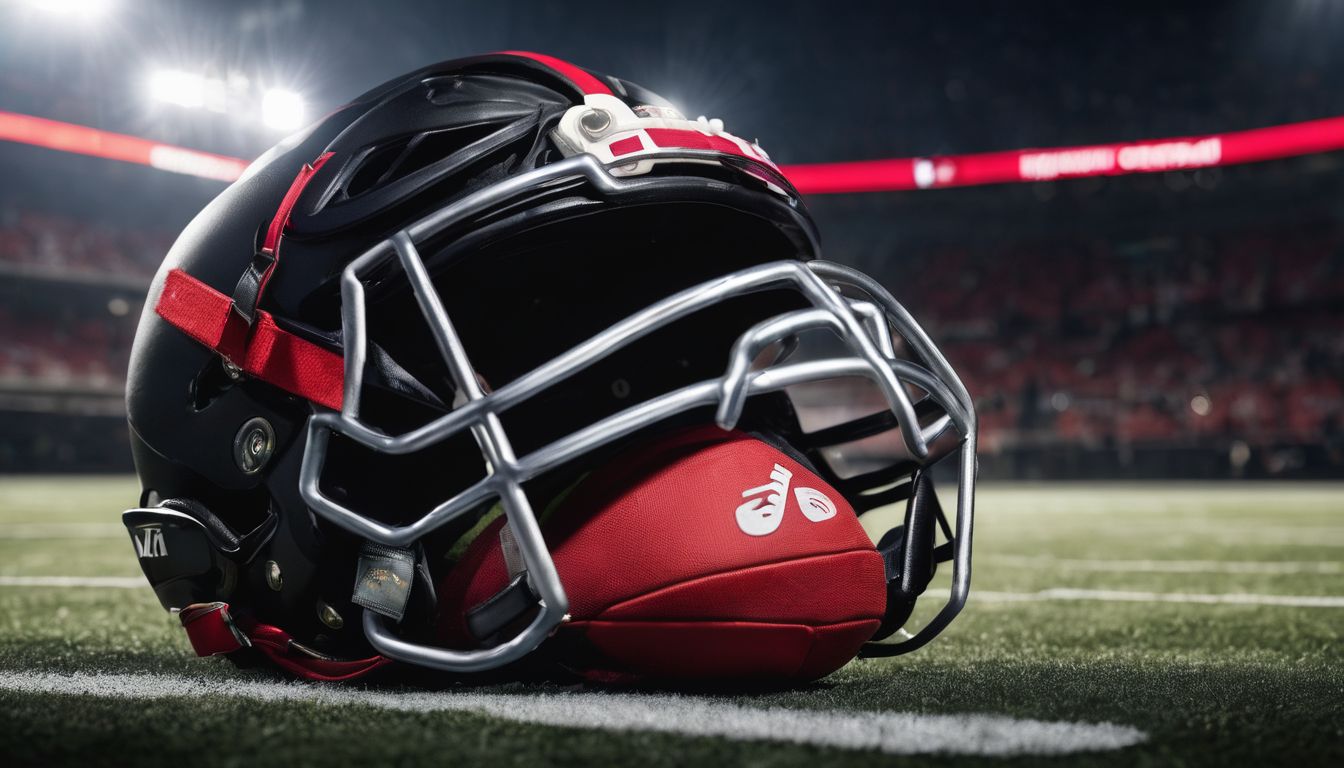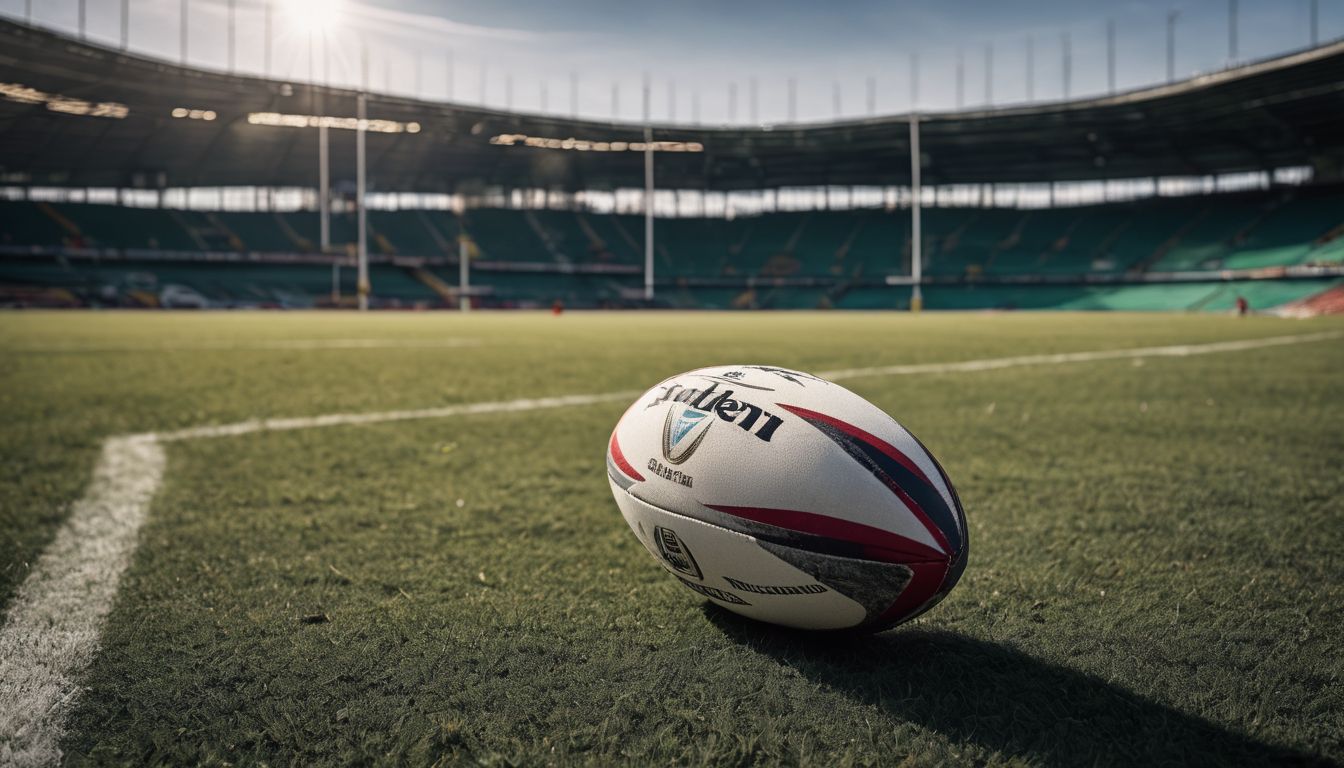The off-season leaves many rugby players wondering how to keep their edge. Stats show top athletes use this time for game-changing fitness and skills enhancement. This article lays out a step-by-step off-season plan, keeping you on track for an explosive return to the pitch.
Dive in and discover tips to stay ahead!
Key Takeaways
- Rugby players use the off-season to recover, enhance physical performance, and improve game-specific skills.
- A structured off-season training plan includes warm-up and cool down routines, resistance training, aerobic and anaerobic fitness exercises, as well as functional hypertrophy workouts.
- Rehab and prehab exercises in early weeks help prevent injuries; mid – phase focuses on building endurance and speed; final weeks target muscle growth for field performance.
- Off-season programs are complemented by skill development drills like passing accuracy, tackling techniques, footwork improvements, and decision-making practices.
- Diet plays an integral role throughout the off – season with nutrition supporting recovery processes and intense training sessions.
Importance of the Off-Season for Rugby Players
The off-season is crucial for rugby players to rest and recover, build strength and conditioning, and develop their skills. It provides them with the opportunity to focus on areas of improvement before the start of the next season.
Rest and recovery
Rest and recovery are vital for rugby players during the off-season. After months of intense matches and continual physical strain, their bodies need time to heal. This period allows muscles to repair, rebuild, and strengthen.
Sleep becomes a top priority to aid recovery processes, while activities like yoga or light swimming can keep muscles limber without adding stress.
Proper nutrition also plays a crucial role in restorative practices. Players focus on eating balanced meals that provide ample protein for muscle repair alongside carbohydrates for energy replenishment.
Hydration is key as well — maintaining fluid levels ensures optimal bodily function during this downtime. Next up is building strength and conditioning..
Building strength and conditioning
Building strength and conditioning is essential for rugby players during the off-season. Through targeted resistance training, players can increase muscle mass, improve power output, and enhance overall physical performance.
Off-season training programs commonly include exercises like power cleans, deadlifts, and bench presses to build strength and explosive force. Additionally, focusing on conditioning through aerobic and anaerobic fitness training helps players maintain their endurance and speed for the upcoming season.
It’s vital to remember that staying in top physical shape during the off-season enables rugby players to perform at their peak when the next season commences.
Developing skills
Transitioning from building strength and conditioning to developing skills, the off-season provides rugby players with an ideal opportunity to focus on enhancing their technical capabilities.
This period allows players to dedicate time specifically towards honing skills such as passing accuracy, tackling techniques, footwork, and decision-making on the field.
During the off-season, rugby players can work on refining specific aspects of their game that may require improvement in preparation for the upcoming season. By consistently practising and developing these fundamental skills during this downtime, players can significantly elevate their overall performance when they return to competitive play.
Components of an Off-Season Training Program
During the off-season, rugby players focus on warm-up and cool down routines, resistance training, aerobic and anaerobic fitness, as well as functional hypertrophy. This structured training program helps players to build strength, improve conditioning and enhance their overall performance on the field.
Warm-up and cool down routines
Rugby fans, warm-up and cool down routines are vital for off-season training. These routines prepare the body for exercise and aid in recovery after training. Here are essential components of effective warm-up and cool down routines:
- Dynamic warm – up exercises, such as high knees, lunges, and leg swings, help to increase blood flow and loosen muscles.
- Incorporating sport-specific movements during warm-ups can help rugby players prepare for the physical demands of their sport.
- Foam rolling and stretching as part of the cool down routine can aid in reducing muscle soreness and preventing injury.
- Cooling down with light aerobic exercise, like jogging or cycling, helps the body gradually return to its resting state.
- Hydration is crucial before, during, and after training sessions to support optimal performance and recovery.
Resistance training
Resistance training is a vital component of an off-season training program for rugby players. It focuses on building muscular strength and power, which are essential for enhancing performance on the field.
Incorporating exercises such as power cleans, deadlifts, bench presses, and split jerks helps rugby players develop the explosive strength needed to excel in the sport. By engaging in resistance training during the off-season, players can work on increasing muscle mass and reducing body fat levels, leading to improved overall physical conditioning.
Moreover, resistance training contributes to injury prevention by strengthening muscles and tendons while also enhancing bone density. This is crucial for rugby players who face high impact and contact during games.
Aerobic and anaerobic fitness
Rugby players focus on both aerobic and anaerobic fitness during the off-season to improve their endurance and explosive power. Aerobic fitness, which involves activities like running, cycling, or swimming, helps players build stamina for sustained performance throughout a match.
Anaerobic fitness, on the other hand, focuses on short bursts of intense activity such as sprinting and agility drills to enhance speed and power needed during game situations. Both types of training are essential for rugby players to meet the demands of the sport and maintain peak physical condition.
During the off-season, rugby players engage in varied cardio exercises such as interval sprints alongside high-intensity strength training sessions to prepare for the rigors of gameplay.
Functional hypertrophy
During the off-season, rugby players often focus on functional hypertrophy, which involves building muscle mass that directly contributes to improved performance on the field. This type of training emphasises specific movements and exercises that translate to increased strength, power, and agility during gameplay.
To achieve functional hypertrophy, rugby players typically incorporate compound resistance exercises such as squats, deadlifts, lunges, and bench presses into their training regimen.
These workouts are designed to target multiple muscle groups simultaneously, mimicking the demands placed on the body during rugby matches and promoting overall physical development.
Sample Off-Season Training Program
In the sample off-season training program, rugby players will focus on rehab and prehab exercises in weeks 1-3, followed by aerobic and anaerobic fitness training in weeks 4-6. Basic strength exercises are then incorporated in weeks 7-9, with functional hypertrophy workouts rounding out the program in weeks 10-12.
Week 1-3: Rehab and prehab exercises
- Rugby players incorporate mobility drills to improve joint range of motion and flexibility, helping in injury prevention and enhancing overall movement quality.
- Foam rolling and massage therapy are used to alleviate muscle tightness and reduce muscle soreness after intense training sessions.
- Stability exercises such as single – leg squats, planks, and balance drills are practised to enhance core strength and improve balance, reducing the risk of injury during matches.
- Resistance band exercises are utilised to strengthen muscles around joints prone to injury, such as the shoulders, knees, and ankles.
- Yoga or Pilates sessions help rugby players improve their body awareness, posture, and breathing techniques while aiding in physical recovery from the previous season’s wear and tear.
Week 4-6: Aerobic and anaerobic fitness training
During weeks 4-6 of the off-season, rugby players focus on aerobic and anaerobic fitness training. This period is crucial for improving cardiovascular endurance and explosive power, essential for on-field performance. The following components are key to this phase of training:
- High – intensity interval training (HIIT) sessions aim to improve anaerobic capacity and boost speed and power.
- Incorporating shuttle runs, sprints, and agility drills helps develop quick bursts of speed and acceleration needed during matches.
- Endurance-focused exercises such as long-distance running or cycling assist in building overall stamina for sustained performance.
- Circuit training combining strength exercises with short bursts of cardio enhances muscular endurance whilst improving cardiovascular fitness.
- Implementing plyometric exercises like box jumps or medicine ball throws helps increase explosive power and agility on the field.
- Utilising sport-specific drills like tackling bags or scrum machine work facilitates rugby-specific conditioning and endurance development.
- Rest and recovery techniques are vital during this phase to allow the body to adapt to the demands of high-intensity training sessions.
- Proper nutrition intake is critical to support energy levels, muscle recovery, and overall performance throughout aerobic and anaerobic fitness training sessions.
- Emphasising proper hydration habits aids in maintaining peak physical condition during rigorous aerobic and anaerobic workouts.
- Consistency in aerobic and anaerobic fitness training during these weeks contributes significantly to a player’s ability to perform at optimal levels once the season resumes.
Week 7-9: Basic strength exercises
Transitioning from focusing on aerobic and anaerobic fitness training, the next phase of the off-season program involves basic strength exercises. This phase aims to continue building on the foundational strength developed in earlier weeks, preparing players for more intense workouts in the following weeks.
- Squats: Rugby players engage in back squats and front squats to strengthen their lower body, which is crucial for explosive movements on the field.
- Deadlifts: Performing deadlifts helps in developing overall strength and power, essential for tackling and scrummaging.
- Pull-ups: Working on pull-ups enhances upper body strength and grip, contributing to improved performance during matches.
- Push-ups: This exercise targets chest, shoulders, and triceps, aiding in developing upper body strength required for various game situations.
- Lunges: Rugby players incorporate lunges to improve leg strength, stability, and balance needed while making quick directional changes during play.
Week 10-12: Functional hypertrophy workouts
Transitioning from basic strength exercises to functional hypertrophy workouts, rugby players enter a period designed to maximise muscle growth and strength endurance. These three weeks focus on targeted resistance training and volume-based workouts, aiming to increase muscle size and power output. During this phase, rugby players should continue their aerobic and anaerobic fitness training alongside the hypertrophy work to maintain overall conditioning.
- Rugby players will perform compound exercises such as squats, deadlifts, bench presses, and pull-ups with moderate to heavy weights and higher repetitions. This will stimulate muscle growth and improve muscular endurance essential for rugby’s physical demands.
- The functional hypertrophy phase incorporates a mix of isolation exercises targeting specific muscle groups like biceps, triceps, shoulders, calves, and abs. This assists in fine-tuning weaker areas and provides overall balance in muscle development.
- Emphasising controlled eccentric movements during the lifts helps reduce the risk of injury while promoting greater muscle tension for enhanced growth. This method supports high-intensity efforts often required in rugby matches.
- Nutrition becomes even more critical during this phase as increased protein intake is necessary to aid in muscle repair and recovery following intense training sessions. Balanced nutrition plays an integral role in maximising the benefits of hypertrophy workouts.
- Rest periods between sets are adjusted to facilitate adequate recovery without compromising intensity. Proper sleep is crucial during these weeks as it directly impacts muscle recovery and growth processes.
Other Activities for Rugby Players During the Off-Season
Incorporating speed and agility drills, metabolic conditioning, and defensive and offensive drills can help rugby players to maintain their fitness levels and improve their skills during the off-season.
Read more about how rugby players navigate the off-season in our blog!
Speed and agility drills
- Agility ladder drills: These exercises involve navigating through a series of ladder rungs laid out on the ground, improving footwork and coordination.
- Cone drills: Utilising cones set up in various patterns helps players work on quick changes of direction and acceleration.
- Shuttle runs: This drill involves sprinting back and forth between two points, enhancing speed, agility, and conditioning.
- Reaction drills: Utilising visual or auditory cues to prompt rapid movements helps improve response time on the field.
- Plyometric exercises: Incorporating explosive jumps and bounds improves power and agility.
Metabolic conditioning
Rugby players incorporate metabolic conditioning into their off-season training to enhance their overall fitness and endurance levels. This type of training focuses on improving the body’s ability to efficiently use energy during high-intensity activities, which is essential for the demands of rugby gameplay.
Players engage in interval training, circuit workouts, and other intensive exercises to elevate their heart rate and increase their stamina. Metabolic conditioning also helps rugby athletes improve their recovery between intense bursts of activity, allowing them to maintain peak performance throughout a match.
Incorporating metabolic conditioning into the off-season training regimen ensures that rugby players are equipped with the physical resilience needed to excel on the field. By prioritising this aspect of conditioning, athletes can build a strong foundation for enduring rigorous matches while optimising their skill sets.
Defensive and offensive drills
Improving defensive and offensive skills is vital for rugby players during the off-season. These drills help players enhance their tactical abilities, decision-making, and positional awareness on the field. By incorporating defensive and offensive drills into their training regimen, rugby players can sharpen their tackling, passing, and positioning techniques to elevate their game.
- Tackle technique drills focus on improving players’ ability to execute effective tackles while maintaining proper body positioning.
- Defensive line drills aim to enhance players’ coordination in defensive formations and communication skills with teammates.
- Position – specific defensive drills help players refine their individual defensive responsibilities based on their positions on the field.
- Offense-oriented passing drills concentrate on honing players’ accuracy, timing, and decision-making when distributing the ball under pressure.
- Scenarios – based offensive drills simulate game situations to improve players’ ability to make quick decisions and exploit opponents’ weaknesses.
- Rucking and mauling drills strengthen players’ ability to secure possession and establish a strong attacking platform during games.
- Vision and awareness drills train players to read the opposition’s defense, identify gaps in the defense, and exploit attacking opportunities effectively.
- Set-piece execution drills enable players to refine their scrummaging techniques, lineout throws, and overall set-piece proficiency for strategic advantage.
Conclusion
In conclusion, the off-season is a crucial time for rugby players to focus on strength training and conditioning. It’s an opportunity to enhance fitness levels, work on specific skills, and improve overall athletic performance.
Off-season training programs often incorporate a range of exercises such as power cleans, deadlifts, and split jerks to build strength and speed. Rugby players can also use this period to fine-tune their diet and nutrition in support of their training and recovery efforts.
Staying in peak physical condition during the off-season ensures that players are ready to perform at their best when the next season rolls around.
FAQs
1. What do rugby players focus on during the off-season?
Rugby players engage in strength training, physical conditioning, and skills development to improve their game performance as part of their off-season training programme.
2. Can amateur rugby players follow a professional off-season training regimen?
Yes, amateur rugby players can adopt an off-season training schedule tailored to enhance their strength, conditioning, and overall sports performance just like the pros.
3. Is it important for rugby athletes to continue contact drills in the off-season?
While contact is essential in rugby, off-season activities often emphasise fitness and non-contact skills through a structured rugby workout programme to prevent injuries.
4. How does conjugate training benefit rugby players in the off-season?
Conjugate training for rugby combines different exercises that boost both strength and flexibility – vital components of an effective off-season strength and conditioning plan.
5. What kind of gym routine should be included in a player’s in-season versus off-season programme?
An athlete should shift from an intense Rugby Inseason Gym Programme focusing on maintaining peak performance levels to a more varied Offseason Rugby Exercise Routine aimed at developing overall athletic abilities.









